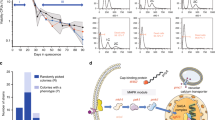Summary
We have investigated the genetic and physiological control of meiosis in fission yeast. Nutritionally depleted h +/h − diploid cells become irreversibly commited to meiosis immediately prior to the initiation of premeiotic S phase. Premeiotic DNA synthesis requires matP +, matM +, mei2 + and mei3 + but not the mitotic cell cycle control gene, cdc2 +, ran1 + is an essential gene, loss of which provokes sexual conjugation, premeiotic DNA synthesis, pseudo-meiosis and the sporulation of haploid cells. Our experiments suggest that sexual differentiation is achieved physiologically by the inhibition of ran1 + activity in a two-step process. In the first step, partial inhibition of ran1 + in starved haploid cells, leads to cell cycle arrest in G1 followed by sexual conjugation. In the second step, a pathway requiring the matP +, matM + and mei3 + genes of the newly-formed zygote, further inhibits ran1 + and thereby commits the cell to meiosis. mei2 + is required for meiotic commitment after full inhibition of ran1 +. ran1 + is normally essential for vegetative cell reproduction but is inessential in cells which have abnormally high levels of cAMP-dependent protein kinase. We propose that the ran1 + gene encodes a highly controlled protein kinase which shares key substrates with cAMP-dependent protein kinase.
Similar content being viewed by others
References
Beach DH (1983) Nature (London) 303:682–687
Beach DH, Klar AJS (1984) EMBO J 3:603–610
Beach DH, Nurse PM (1981) Nature (London) 200:140–142
Beach DH, Durkacz B, Nurse PM (1982) Nature (London) 300:706–709
Beach DH, Piper M, Nurse PM (1982) Mol Gen Genet 187:326–329
Bresch C, Miller G, Egel R (1968) Mol Gen Genet 102:301–306
Egel R (1971) Planta 98:89–96
Egel R (1973) Mol Gen Genet 121:277–284
Egel R (1981) Cold Spring Harbor Symp Quant Biol XLV:1003–1007
Egel R, Egel-Mitani M (1974) Cell Res 88:127–134
Esposito RE, Esposito MS (1974) Proc Natl Acad Sci USA 71:3172–3176
Gutz H, Heslot H, Leupold U, Loprieno N (1974) Schizosaccharomyces pombe. In: King RC (ed) Handbook of genetics, vol 1. Plenum Press, New York, pp 395–446
Hartwell LH (1974) Bacteriol Rev 38:164–198
Hindley J, Phear G (1984) Gene 31:129–134
Iino Y, Yamamoto M (1985a) Mol Gen Genet 198:416–421
Iino Y, Yamamoto M (1985b) Proc Natl Acad Sci USA 82:2247–2451
Jonke R, Padilla GM (1979) J Gen Microbiol 115:255–258
Kassir Y, Simchen G (1976) Genetics 82:187–206
Leupold U (1970) Genetical methods for Schizosaccharomyces pombe. In: Prescott DM (ed) Academic Press, New York, pp 169–177
Matsumoto K, Uno I, Ishikawa T (1983) Cell 32:417–423
Mitchinson MM, Creanor J (1971) Exp Cell Res 69:244–247
Nakaseko Y, Niwa O, Yanagida M (1984) J Bacteriol 157:334–336
Nasmyth KA (1979) J Cell Sci 36:155–168
Nurse PM (1975) Nature (London) 256:547–551
Nurse PM (1985) Mol Gen Genet 198:497–502
Nurse PM, Bissett (1981) Nature (London) 292:558–560
Nurse PM, Thuriaux P (1977) Exp Cell Res 107:365–375
Nurse PM, Thuriaux P (1980) Genetics 96:627–637
Rothstein R (1983) Methods Enzymol 101:202–211
Sherman F, Roman H (1963) Genetics 48:255–261
Shilo V, Simchen G, Shilo B (1978) Exp Cell Res 112:241–248
Simchen G, Pinon R, Salts Y (1972) Exp Cell Res 75:207–218
Thuriaux P, Nurse PM, Carter B (1978) Gen Genet 161:215–220
Toda T, Uno I, Ishikawa T, Powers S, Kataoka T, Broek D, Cameron S, Broach J, Matsumoto K, Wigler W (1985) Cell 40:27–36
Author information
Authors and Affiliations
Rights and permissions
About this article
Cite this article
Beach, D., Rodgers, L. & Gould, J. RAN1 + controls the transition from mitotic division to meiosis in fission yeast. Curr Genet 10, 297–311 (1985). https://doi.org/10.1007/BF00365626
Received:
Issue Date:
DOI: https://doi.org/10.1007/BF00365626




